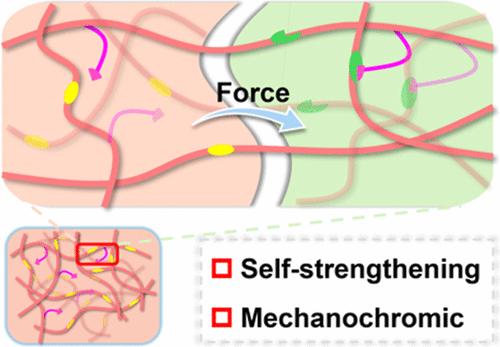Weak Covalent Bonds and Mechanochemistry for Synergistic Self-Strengthening of Elastomers
IF 14.4
1区 化学
Q1 CHEMISTRY, MULTIDISCIPLINARY
引用次数: 0
Abstract
The macroscopic properties of elastomers are intimately linked to their molecular reactivity and mechanisms. Here, we propose a new strategy for designing strengthening materials based on the synergy of weak covalent bonds and mechanochemistry. After mechanical treatment, the failure strength and toughness of the elastomer increased from 2.37 ± 0.05 MPa and 11.34 ± 0.30 MJ/m3 to 6.02 ± 0.04 MPa and 18.40 ± 0.30 MJ/m3, respectively, while maintaining excellent tensile properties. Notably, experimental tests, theoretical calculations, and small-molecule reaction model results show that the sulfur–carbon bond is more prone to homolysis, and the reactive sites are between sulfur radicals and the end-positioned carbon of the vinyl. The C–S weak bond of spirothiopyran (STP) first undergoes homolysis to dissipate energy suffering from external stress, and the radical-mediated click reaction leads to the interchain cross-linking, thus enhancing the mechanical strength. In the end, the prepared elastomer is further used to construct a photonic elastomer, which exhibits not only mechanical force-enhanced strength but also mechanochromism. The present work provides an opportunity for innovative design of self-strengthening materials, and the prepared novel self-strengthening elastomer has broad applications in visualized strain monitoring, electronic skin, soft robots, and other fields.

求助全文
约1分钟内获得全文
求助全文
来源期刊
CiteScore
24.40
自引率
6.00%
发文量
2398
审稿时长
1.6 months
期刊介绍:
The flagship journal of the American Chemical Society, known as the Journal of the American Chemical Society (JACS), has been a prestigious publication since its establishment in 1879. It holds a preeminent position in the field of chemistry and related interdisciplinary sciences. JACS is committed to disseminating cutting-edge research papers, covering a wide range of topics, and encompasses approximately 19,000 pages of Articles, Communications, and Perspectives annually. With a weekly publication frequency, JACS plays a vital role in advancing the field of chemistry by providing essential research.

 求助内容:
求助内容: 应助结果提醒方式:
应助结果提醒方式:


